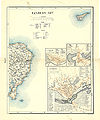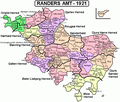Hjelm (island)
| Helmet | ||
|---|---|---|
| Hjelm of Djursland (southern tip Hassensør ) from a distance of 5 km | ||
| Waters | Kattegat | |
| Geographical location | 56 ° 8 '0 " N , 10 ° 48' 10" E | |
|
|
||
| length | 1.4 km | |
| width | 760 m | |
| surface | 62.2 ha | |
| Highest elevation | Fyrbakken 39 m |
|
| Residents | uninhabited | |
| Hjelm lighthouse | ||
Hjelm is a small, uninhabited island in the Kattegat , which belongs to Denmark .
geography
Hjelm is located 4.9 km east of the headland Hassensør of Djursland , separated from it by Hjelm Dyb . The island has an area of 62.2 hectares and reaches a height of 39 meters in Fyrbakken. On the Fyrbakken the 18-meter-high stands photovoltaic -powered lighthouse Hjelm Light . Hjelm is the first island in Denmark with a photovoltaic lighthouse.
There are several shoals within five kilometers of the island :
- Hjelm Banke (the immediate area on which the island rests)
- Klørgrund (southeast, 6.4 meters depth)
- Bjarkesgrund (south, 56 ° 06'N 10 ° 46'E, 4 meters depth)
- Skelhøjsgrunde (north, 56 ° 10'N 10 ° 43'E, 5 meters depth)
- Klokkegrund (west, 56 ° 08'N 10 ° 44'E, 2.8 meters depth)
- Øreringene (southwest, 56 ° 07'N 10 ° 44'E, 4.4 meters depth)
administration
The island belongs to the parish community ( Danish : Sogn ) Ebeltoft Sogn , which belonged to Harde Mols Herred in the then Randers office until the Danish municipal reform of 1970 , then to the Ebeltoft municipality in the then Århus office . which became part of the Syddjurs municipality in the Midtjylland region with the next Danish municipal reform in 2007 .
history
Hjelm was already inhabited in the Stone Age. The island was first mentioned in history in 1286 in connection with the murder of Erik V. Klippings in Finderup Lade. The Danish marshal Marsk Stig , accused of murder, fortified Hjelm in 1290 and operated a counterfeiting factory from there.
On November 15, 1856, today's lighthouse went into operation, initially powered by rapeseed oil, later by petroleum, electricity and finally solar energy. With the lighthouse, the lighthouse keeper and his assistant, the stoker and a classroom with up to 15 students brought new life to the island.
In 1947 Hjelm was sold to Århus Stenog Gruskompagni (" Århus Stone and Gravel Company"), which mined gravel and rubble on the island.
While 10 to 30 people still lived on Hjelm in the early 1900s, the island steadily lost its population after the Second World War and has been without permanent residents since the late 1960s.
In 1964 the obligation to use the island for agriculture was lifted.
In 1970 the lighthouse keeper left the island after the lighthouse operation was automated.
With the exception of the lighthouse property, the island is now privately owned by a family who are related to the then owner of the stone and gravel company and who use the island as a holiday home.
There are still two residential buildings on the island, including a former farm.
gallery
literature
- Niels Houkjær: Hjelm. In: De danske øer - En lystrejse til Danmarks småøer. Nordisk Forlag A / S, Copenhagen 2006, ISBN 87-02-04176-6 , p. 85 ff. (Danish)
See also
Individual evidence
- ↑ Danmarks Statistics : Statistisk Aarbog 1920 - Table 3: Arealets Fordeling paa de forskellige større og minre Landsdele including Folkemængde og Befolkningstæthed on February 1, 1916, footnote 14 (Danish / French; PDF; 1.1 MB)
Web links
- Digital archive: Hjelm. (Danish)
- Excavations on Hjelm 1854-1999 (Danish) (PDF file; 662 kB)
- Homepage of the island of Hjelm (Danish)






